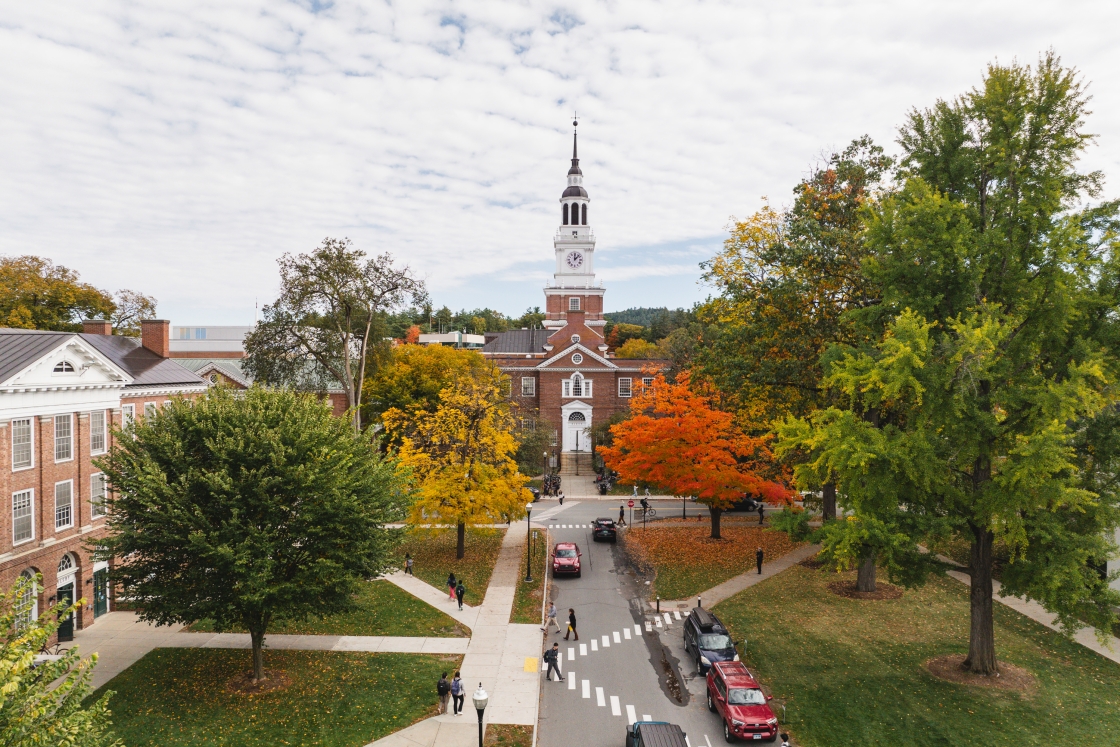The archived U.S. Marine field records pinpoint the coordinates: In the “Dodge City” area about 10 miles south of Da Nang in the Quang Nam Province of South Vietnam, 2nd Lt. William “Billy” Smoyer ’67 died in a rice paddy on July 28, 1968.
Defense department documents from a database of Vietnam casualties led President Emeritus James Wright last month to the spot where Smoyer, a platoon leader, and 18 others from Kilo Company, 7th Marines, were killed in an ambush in the summer of ’68.
Wright found the rice paddy, which is much the same today as it was 46 years ago, and placed a Dartmouth hockey puck with a “Semper Fidelis” sticker in the field, then covered it with dirt from the Dartmouth Green. Smoyer, a star hockey player at the College, began active duty as a U.S. Marine after graduation.
Wright traveled to Vietnam in August and September to do research for his upcoming book, a history of the Vietnam War in the pivotal year of 1969, as told by the men and women who served there and the survivors of those who fell.
Wright visited many of the places he is writing about, and he attempted to locate places where Dartmouth men died in the war. With a briefcase full of military maps and death records from the era, he tracked down precise locations where three U.S. Marines, Smoyer, Duncan Sleigh ’67, and Philip Barger ’65, were killed in action. Wright left a small token of Dartmouth at each site.
Wright, who joined the Marine Corps when he was 17, says he was struck by the juxtaposition of the old and new Vietnam, and by the extent of change amid timelessness.
In the paddy where Smoyer died, Wright says, “People were working in the field. Water buffalo stood nearby, indifferent to all of us.”
In another killing field, a man who lived in a nearby house invited the group for tea. “He had lived in that house for all of his 85 years. He served during the war with the local Viet Cong unit,” Wright says.
Wright’s most recent book, Those Who Have Borne the Battle: A History of America’s Wars and Those Who Fought Them, published in 2012, focused on the experience of veterans throughout this country’s history, from the American Revolution to the war in Afghanistan.
This new book will examine the transitional year of 1969, Wright says, focusing on a 30-day period including a punishing 11-day battle for a mountain near the border with Laos. The 101st Airborne Division fought North Vietnamese regulars in May 1969 for control of the site designated as Hill 937 on U.S. military maps, but known to American soldiers as “Hamburger Hill.” The U.S. operation took the hill, but only after 71 Americans died and 372 were wounded. Some estimates put the Vietnamese deaths at 600.
Read more:
“I interviewed a lot of people. The hill was bombed savagely. It was described as a ‘moonscape’—a terrible fight,” Wright says. Once the hill was taken, the North Vietnamese melted away and the site lost its tactical value. The U.S. military withdrew, and “some say the North Vietnamese were back within 30 days. There was a lot of controversy,” Wright says. The place of the battle became a symbol of the war.
Wright climbed Hamburger Hill, or Dong Ap Bia Mountain on today’s maps, with Vietnam veteran Bruce Jones, who is now a guide with Military Historical Tours, two local men from the nearby village of A Luoi who served in the North Vietnamese army and fought in the battle, and two local officials.
“The jungle has returned. There is a triple level of canopy. As we walked, it was slippery, hot and muggy. But scars were visible—B-52 bomb craters full of stagnant water, tunnel entrances,” Wright says.
The two North Vietnamese veterans were eager guides for the Americans. “They showed us edible plants and called the names of flowers,” Wright says.
At the top, there is a monument erected by the communist government in 2009 celebrating “a victorious place.”
It would be hard to find a victor in that savage battle, Wright says, but the communists reclaimed the hill without a fight within a month, “and six years later would occupy Saigon and win the war. I suppose it is now their hill and they can put up any sign they want.”
Wright is still working through scores of interviews and compiling notes for the book. On the walls of his Hanover office are modern maps of Vietnam and military maps from the era. But an important part of the project was completed, he says, when he left a little piece of the College behind to honor the Dartmouth men who died in that war.
He also left a personal memorial at the top of Dong Ap Bia Mountain for a young man from the mining town where he grew up, Galena, Ill. He came to know him “as an English student at the local high school when I taught there in a student teaching program. This young man had died in May 1969 with the 187th on Hamburger Hill. I dug a small hole and left behind a small piece of lead—of galena.”
